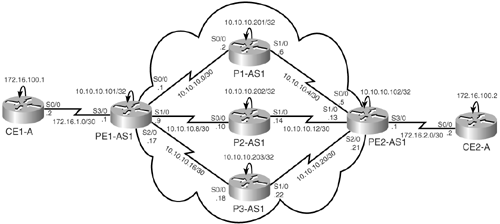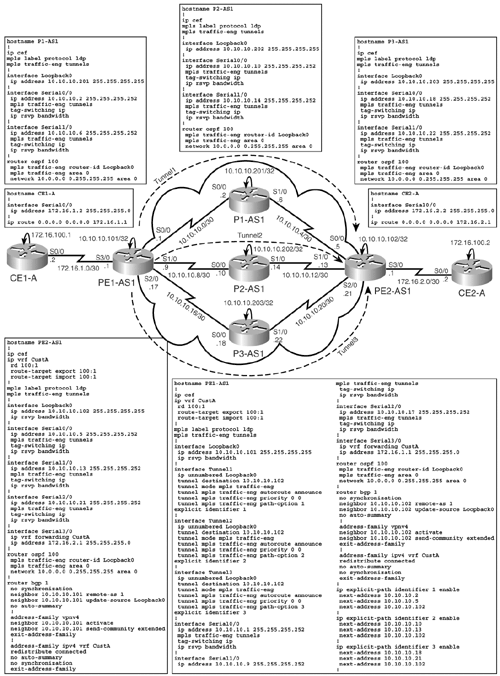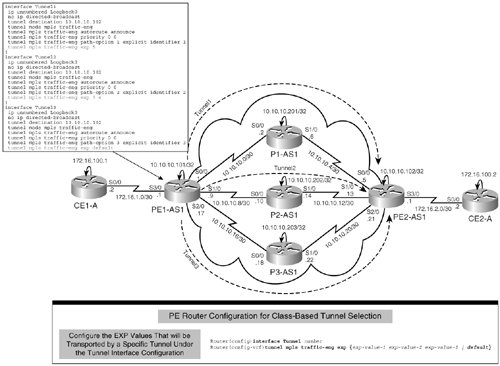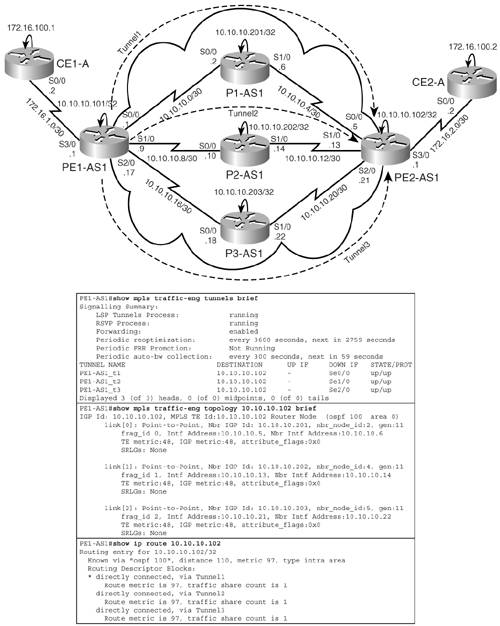Case Study 6: Implementing Class-Based Tunnel Selection with MPLS Traffic Engineering
Case Study 6 Implementing Class Based Tunnel Selection with MPLS Traffic Engineering
Figure 14-38 shows an SP network, consisting of PE Routers PE1-AS1 and PE2-AS1 and provider core Routers P1-AS1, P2-AS1, and P3-AS1, providing MPLS VPN services to Customer A Sites 1 and 2.
Figure 14-38. Case Study 6: Topology

The SP wants to implement traffic engineering (TE) in conjunction with MPLS VPN matching the following paths:
- Higher priority traffic (real-time MPLS EXP=5) follows the path via P1-AS1.
- EXP=4 and EXP=3 follow the path via P2-AS1.
- All other EXP-based traffic will follow the path via P3-AS1.
Implementing Class-Based Tunnel Selection
MPLS TE Class-Based Tunnel Selection (CBTS) enables the SP to dynamically route and forward traffic of different classes of service (CoS) into different TE tunnels between the same tunnel headend and the same tailend where the tunnels can be DS-TE aware. The set of TE (or DS-TE) tunnels from same headend to same tailend that are configured to carry different CoS values is referred to as a "tunnel bundle." After configuration, CBTS dynamically routes and forwards packets into the tunnel that is configured to carry the CoS of the packets.
Figure 14-39 shows the base configurations for all devices in the network prior to the implementation of CBTS. The base configurations show the implementation of three static (explicit) tunnels on the PE1-AS1 router.
Figure 14-39. Case Study 6: Base Configuration Prior to CBTS Implementation

Configuring CBTS
Figure 14-40 outlines the configuration flowchart for the implementation of CBTS, as well as the configuration of the PE1-AS1 router to implement CBTS.
Figure 14-40. Case Study 6: Configuration of CBTS

As shown in the highlighted section in Figure 14-40, the configuration of the PE1-AS1 router shows that Tunnel1 transports packets with MPLS EXP value of 5, Tunnel2 transports packets with MPLS EXP values of 3 and 4, and Tunnel3 is used to transport packets of all other MPLS EXP values.
CBTS supports tunnel selection based on the value of the EXP field that the headend router, taking into account the input Modular QoS CLI (MQC), imposes on the packet. If the input MQC modifies the EXP field value, MPLS TE CBTS uses the modified value for its tunnel selection. It is important to note that if the output MQC modifies the EXP field, CBTS ignores the change in the EXP value.
Verification of Class-Based Tunnel Selection
Verification of CBTS is shown in Figure 14-41. Verification of tunnel status by issuing a show MPLS traffic-eng tunnels brief on PE1-AS1 is shown along with verification of TE topology and next-hop pointing to all three tunnels and tunnel association into IGP.
Figure 14-41. Case Study 6: Verification of CBTS

Final Configurations for Case Study 6
The final configurations for Case Study 6 for the PE Routers PE1-AS1 and PE2-AS1 to implement CBTS are shown in Figure 14-42. For all other device configurations, refer Figure 14-39.
Figure 14-42. Case Study 6: Final Configurations for PE Routers

MPLS Overview
- MPLS Overview
- Unicast IP Forwarding in Traditional IP Networks
- Overview of MPLS Forwarding
- MPLS Terminology
- MPLS Control and Data Plane Components
- MPLS Operation
- Special Outgoing Label Types
- Penultimate Hop Popping
- Frame-Mode MPLS
- Cell-Mode MPLS
Basic MPLS Configuration
- Basic MPLS Configuration
- Frame-Mode MPLS Configuration and Verification
- Cell-Mode MPLS over ATM Overview, Configuration, and Verification
- Command Reference
Basic MPLS VPN Overview and Configuration
- Basic MPLS VPN Overview and Configuration
- VPN Categories
- MPLS VPN Architecture and Terminology
- MPLS VPN Routing Model
- MPLS VPN Basic Configuration
- Outbound Route Filters
- Command Reference
PE-CE Routing Protocol-Static and RIP
- PE-CE Routing Protocol-Static and RIP
- Static PE-CE Routing Overview, Configuration, and Verification
- Static PE-CE Routing Command Reference
- RIPv2 PE-CE Routing Overview, Configuration, and Verification
- RIPv1 PE-CE Routing Configuration and Verification
- RIP PE-CE Routing Command Reference
PE-CE Routing Protocol-OSPF and EIGRP
- PE-CE Routing Protocol-OSPF and EIGRP
- OSPF PE-CE Routing Protocol Overview, Configuration and Verification
- EIGRP PE-CE Routing Protocol Overview, Configuration, and Verification
Implementing BGP in MPLS VPNs
- Implementing BGP in MPLS VPNs
- BGP PE-CE Routing Protocol Overview, Configuration, and Verification
- Implementing Route-Reflectors in MPLS VPN Networks
- Case Study-Hub and Spoke MPLS VPN Network Using BGP PE-CE Routing for Sites Using Unique AS Numbers
- Case Study-Hub and Spoke MPLS VPN Network with Sites Using Same AS Numbers
- Command Reference
Inter-Provider VPNs
- Inter-Provider VPNs
- Overview of Inter-Provider VPNs
- Option 1: Inter-Provider VPN Using Back-to-Back VRF Method
- Option 2: Inter-Provider VPNs Using ASBR-to-ASBR Approach
- Option 3: Multi-Hop MP-eBGP Between RR and eBGP Between ASBRs
- Option 4: Non-VPN Transit Provider
- Case Study-Inter-AS Implementing Route-Reflector and BGP Confederation in Provider Networks
- Case Study-Multi-Homed Inter-AS Provider Network
- Command Reference
Carrier Supporting Carriers
- Carrier Supporting Carriers
- Carrier Supporting Carriers Overview
- Deployment Scenarios with CSC Architecture
- CSC Architecture Benefits
- Command Reference
MPLS Traffic Engineering
- MPLS Traffic Engineering
- TE Basics
- MPLS TE Theory
- Constraint-Based Routing and Operation in MPLS TE
- Configuring MPLS TE
- Command Reference
Implementing VPNs with Layer 2 Tunneling Protocol Version 3
- Implementing VPNs with Layer 2 Tunneling Protocol Version 3
- L2TPv3 Overview
- Configuring L2TPv3 Tunnels for Layer 2 VPN
- Configuring L2TPv3 Static Tunnels
- Configuring L2TPv3 Dynamic Tunnels
- Implementing Layer 3 VPNs over L2TPv3 Tunnels
- Command Reference
Any Transport over MPLS (AToM)
- Any Transport over MPLS (AToM)
- Introduction to Layer 2 VPNs
- Implementing AToM for Like to Like Circuits
- L2 VPN-Any to Any Interworking
- Local Switching
- Command Reference
Virtual Private LAN Service (VPLS)
- Virtual Private LAN Service (VPLS)
- VPLS Overview
- VPLS Topology-Single PE or Direct Attachment
- Hierarchical VPLS-Distributed PE Architecture
- Command Reference
Implementing Quality of Service in MPLS Networks
- Implementing Quality of Service in MPLS Networks
- Introduction to QoS-Classification and Marking
- MPLS QoS Implementation
- MPLS QoS Operating Modes
- Modular QoS CLI: Configuration of QoS on Cisco Routers
- Configuration and Implementation of MPLS QoS in Uniform Mode and Short Pipe Mode Operation
- Implementing MPLS QoS for Layer 2 VPN Implementations
- Command Reference
MPLS Features and Case Studies
- MPLS Features and Case Studies
- Case Study 1: Implementing Multicast Support for MPLS VPNs
- Case Study 2: Implementing Multi-VRF CE, VRF Selection Using Source IP Address, VRF Selection Using Policy-Based Routing, NAT and HSRP Support in MPLS VPN, and Multicast VPN Support over Multi-VRF CE
- Case Study 3: Implementing Layer 2 VPNs over Inter-AS Topologies Using Layer 2 VPN Pseudo-Wire Switching
- Case Study 4: Implementing Layer 3 VPNs over Layer 2 VPN Topologies and Providing L2 VPN Redundancy
- Case Study 5: Implementing Dynamic Layer 3 VPNs Using mGRE Tunnels
- Case Study 6: Implementing Class-Based Tunnel Selection with MPLS Traffic Engineering
- Case Study 7: Implementing Hub and Spoke Topologies with OSPF
- Case Study 8: Implementing Hub and Spoke Topologies with EIGRP
- Case Study 9: Implementing VPLS Services with the GSR 12000 Series
- Case Study 10: BGP Site of Origin
- Command Reference
EAN: 2147483647
Pages: 130
